Summary
Rev Bras Ginecol Obstet. 2024;46:e-rbgo7
To validate the 10-item Cervantes Scale (CS-10) among Brazilian women.
This is a cross-sectional observational study involving women in the community aged 40–55 years in the Southern region of Brazil. They completed a general health, habits and socio-demographic questionnaire, the CS-10 and the Women’s Health Questionnaire (WHQ). Women unable to understand the survey, not consenting to participate, or having incapacity imposing difficulties during the completion of the questionnaire were excluded. A Confirmatory Factor Analysis (CFA) was conducted with the AMOS 16.0 software. Chi-square of degrees of freedom (χ2/df), the Comparative Fit Index (CFI), the Tucker-Lewis Index (TLI) and the Root-Mean-Square Error of Approximation (RMSEA) were used as indices of goodness of fit. Cronbach’s alpha coefficient was used for internal consistency.
A total of 422 women were included (premenopausal n=35, perimenopausal n=172, postmenopausal n=215). The CFA for the CS-10 showed a good fit (χ²/df=1.454, CFI=0.989; TLI=0.985; RMSEA=0.033; CI 90%=0.002-0.052; PCLOSE=0.921; Model p=0.049). Good reliability was established in CS-10 and WHQ (Cronbach’s alpha=0.724). Postmenopausal women had higher total CS-10 scores (p≤0.0001), reflecting worse quality of life (QoL) related to menopause symptoms and confirming the greater symptomatology evaluated by high total scores for WHQ found in this population when compared to those in the premenopausal period (p=0.041).
The CS-10 is a consistent tool for health-related QoL in Brazilian mid-aged women.
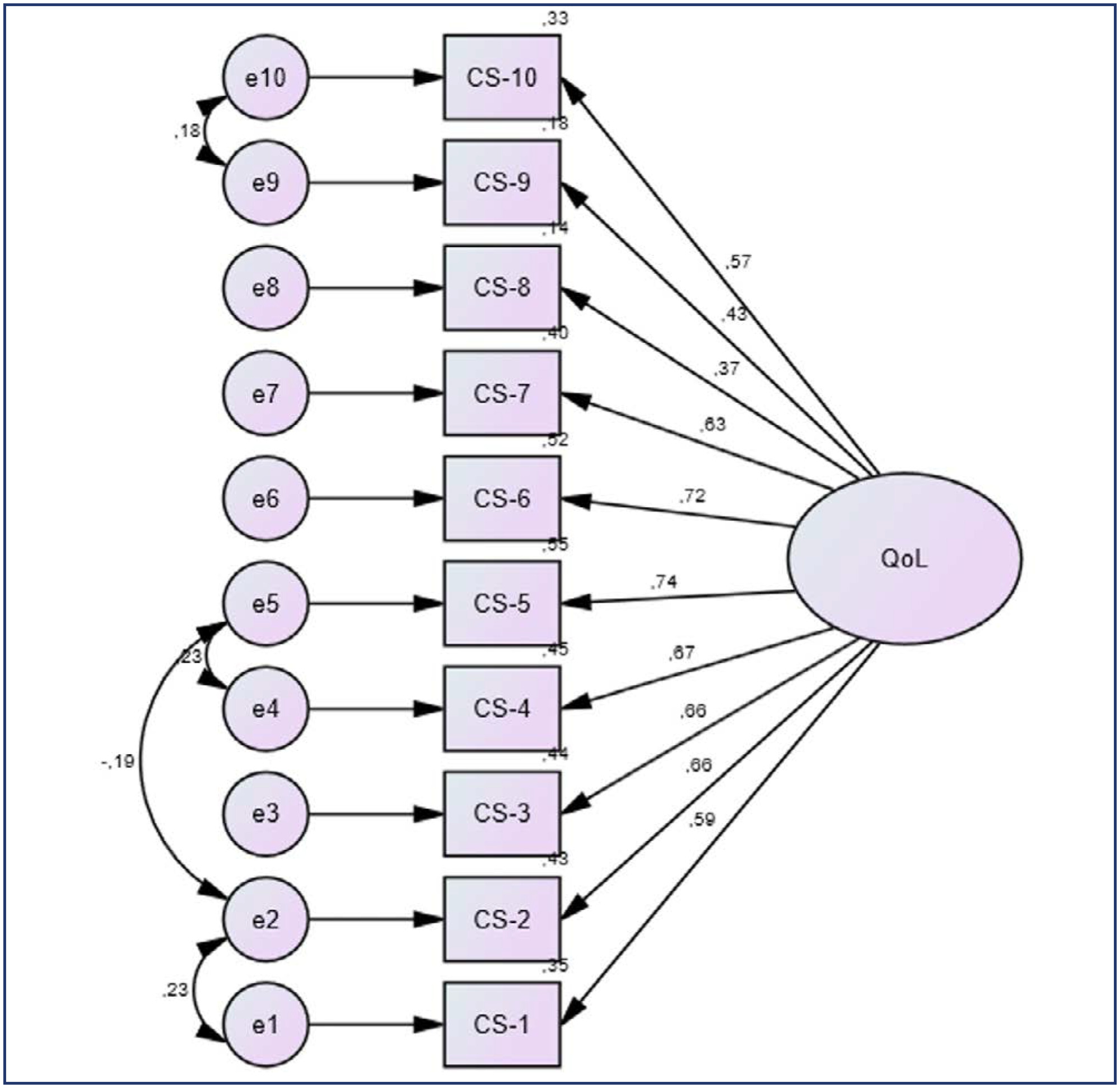
Summary
Rev Bras Ginecol Obstet. 2023;45(12):796-807
Menopause causes several changes in the body that may affect the response to COVID-19. We aimed to investigate the possible association between menopausal status and incidence and outcomes in COVID-19 patients.
Combinations of keywordsCOVID-19, menopause, and estrogen were used to search the PubMed, Embase, Web-of-Science, and Scopus databases for articles reporting the incidence and outcomes of COVID-19 (discharge, length-of-admission, intensive care, or mortality) in premenopausal women, available through December 29, 2022. Data from studies comparing the incidence of COVID-19 infection with the age-matched male population were pooled and meta-analyzed using a random-effects model.
Overall, 1,564 studies were retrieved, of which 12 were finally included in the systematic review to compare disease outcomes, and 6 were meta-analyzed for the incidence of COVID-19 in premenopausal and postmenopausal women. All studies reported better COVID-19-associated outcomes in premenopausal women compared with postmenopausal women. After adjusting for confounding factors, three studies found better outcomes in postmenopausal women, and two found no association between menopausal status and COVID-19 outcomes. Our meta-analysis found a higher incidence of COVID-19 infection among premenopausal women than postmenopausal women, when compared with age-matched men (odds ratio = 1.270; 95% confidence interval: 1.086–1.486; p = 0.003).
The incidence of COVID-19 was significantly higher in premenopausal women than in postmenopausal women when compared with age-matched men. Although premenopausal women may have more favorable COVID-19-associated outcomes, the presumed preventive effect of estrogens on the incidence and related outcomes of COVID-19 in premenopausal women cannot be proven at present. Further longitudinal studies comparing pre- and post-menopausal women are required to provide further insight into this matter.

Summary
Rev Bras Ginecol Obstet. 2021;43(7):535-544
To investigate the feasibility of pelvic floor muscle training (PFMT) through gametherapy for relieving urinary symptoms of climacteric women with stress ormixed urinary incontinence (UI).
Randomized clinical trial, divided into two groups: Gametherapy (G_Game) and Control (G_Control). Both groups received recommendations about unsupervised PFMT, and G_Game also received supervised PFMT through gametherapy. After 5 consecutive weeks, the feasibility was investigated considering participant adherence, urinary symptoms (evaluated by the International Consultation on Incontinence Questionnaire-Urinary Incontinence Short Form [ICIQ-UI-SF] questionnaire), and pelvic floor function (PERFECT Scheme: power, endurance, repetition and fast). The Fisher exact, Kruskal-Wallis, Wilcoxon sign paired, and Mann-Whitney U tests were used by intention-to-treat analysis, using STATA 15.1 (StataCorp, College Station, TX, USA) software.
The present study included 20 women per group and observed a higher adherence in G_Game. In the intragroup analysis, a decrease in the ICIQ-UI-SF score was observed in both groups (14.0 to 10.0; 13.5 to 0), associated with increased endurance (2.5 to 3.5; 2.5 to 4.0) in G_Control and G_Game, respectively. Moreover, there was a concomitant increase in pelvic floor muscles (PFMs) power (2.0 to 3.0), repetition (3.0 to 5.0), and fast (10.0 to 10.0) in G_Game. In the intergroup analysis, a reduction of UI was observed (p<0.001; r=0.8), as well an increase in PFM power (p=0.027, r=0.2) and endurance (p=0.033; r=0.3) in G_Game.
The feasibility of supervised PFMT through gametherapy was identified by observing participant adherence, relief of urinary symptoms, and improvement in PFM function.
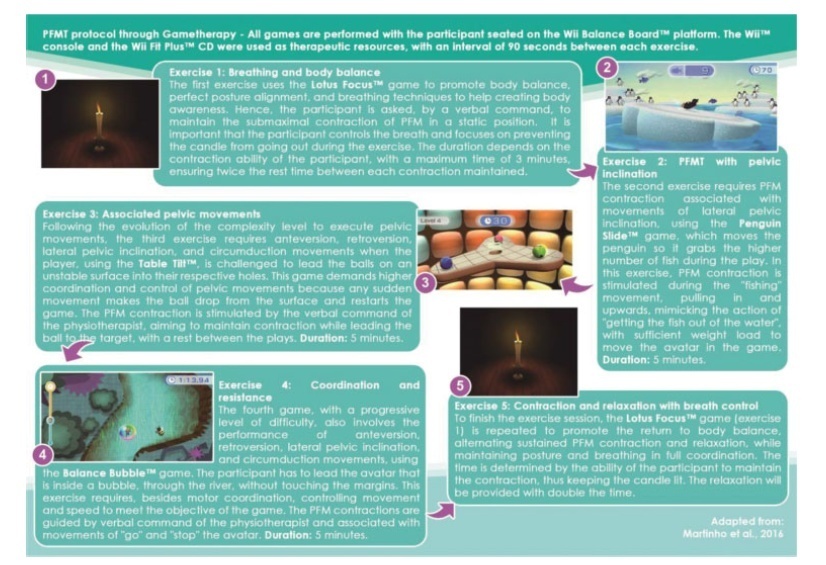
Summary
Rev Bras Ginecol Obstet. 2019;41(7):432-439
To validate the six-item female sexual function index (FSFI-6) in middleaged Brazilian women.
Cross-sectional observational study, involving 737 (premenopausal n = 117, perimenopausal n = 249, postmenopausal n = 371) Brazilian sexually active women, aged between 40 and 55 years, not using hormonal contraceptive methods. The Brazilian FSFI-6 was developed from the translation and cultural adaptation of the Portuguese FSFI-6 version. The participants completed a general questionnaire, the FSFI-6, and the menopause rating scale (MRS). The validation was performed by AMOS 16.0 software (SPSS, Inc., Chicago, IL, USA) for a confirmatory factor analysis (CFA). The chi-square of degrees of freedom (χ2/df), the comparative fit index (CFI), the Tucker- Lewis index (TLI) and the root-mean-square error of approximation (RMSEA) were used as indices of goodness of fit. Cronbach α coefficient was used for internal consistency.
The process of cultural adaptation has not altered the Brazilian FSFI-6, as compared with the original content. The CFA for the FSFI-6 score showed an acceptable fit (χ2/df = 3.434, CFI = 0.990, TLI = 0.980, RMSEA = 0.058, 90% confidence interval (90%CI) = 0.033-0.083, p ≤ 0.001) and a good reliability was established in FSFI-6 and MRS (Cronbach α = 0.840 and = 0.854, respectively). In addition, 53.5% of the sample had low sexual function.
The FSFI-6 was translated and adapted to the Brazilian culture and is a consistent and reliable tool for female sexual dysfunction screening in Brazilianmiddleaged women.
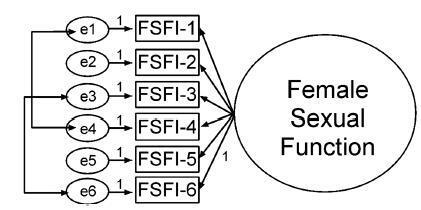
Summary
Rev Bras Ginecol Obstet. 2017;39(12):663-669
To examine the role of the panoramic mandibular radiograph in the diagnosis of low bone mineral density (BMD) in postmenopausal women.
A cross-sectional study including volunteer women aged over 40 years in amenorrhea due to ovarian failure for at least 12 months, who were cared for at the climacteric outpatient clinic of a university hospital in the city of Cuiabá, in the state of Mato Grosso, Brazil. The panoramic radiographs were evaluated using a specific software. Two aspects were analyzed in the mandibular panoramic radiograph: a qualitative aspect regarding the shape of the mandibular cortical bone, and a quantitative aspect regarding thewidth of themandibular cortical bone. Themorphology of themandibular cortical bone in the digital panoramic radiograph was determined bilaterally by the observation of the bone structure between the mental foramen and the base of the jaw. The mandibular cortical bonewas categorized into three groups. Themental index (MI)was used to evaluate the thickness of themandibular cortical bone through a perpendicular line drawn fromthe base of the mandible at the height of the center of the mental foramen, with another line drawn tangent to the inferior border of the mandible, and a third line parallel to the line at the superior border of themandible. The MI data are expressed in millimeters, with a normal value of 3.0 mm. The densities of the lumbar spine and femur, expressed in g/cm2, were categorized as normal, osteopenia or osteoporosis.
The agreement index between the MI and the BMD of the lumbar spine was good (Kappa = 0.718), but the same index between the MI and the BMD of the femoral neck was poor (Kappa = 0.443). An excellent agreement occurred when the mandibular cortical index (MCI) was compared with the BMD of the lumbar spine (Kappa = 0.912). The agreement between MCI and the BMD in the femur was moderated (Kappa = 0.579).
The radiomorphometric indices evaluated in the mandibular panoramic radiograph are capable of identifying postmenopausal women with low mineral density in the mandible, and the results can be used to refer these women to appropriate medical investigation and/or treatment.
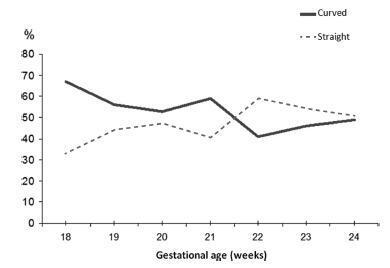
Summary
Rev Bras Ginecol Obstet. 2017;39(2):66-71
To investigate the association between the intensity of climacteric symptoms and sexual dysfunction in women aged 40 to 65 years.
Observational, analytic, cross-sectional study conducted with 63 women aged 40 to 65 treated at the gynecology outpatient clinic of a public hospital in northeastern Brazil. A questionnaire was used to collect identification data, clinical information, gynecological-obstetric data, lifestyle traits and information on chronic diseases. Climacteric symptoms and sexual function were evaluated by means of the Blatt-Kupperman index and the Female Sexual Function Index (FSFI) respectively. The association between the two indices was investigated using the chi-squared test; the difference in mean scores on the FSFI as a function of menopausal status was evaluated by Student's t-test. The significance level was set to p < 0.05.
The mean value of the Blatt-Kupperman index was 26.42 (standard deviation [SD]: 4.52); 36.51% of the women exhibited severe symptoms. The mean score on the FSFI was 21.84 (SD: 4.11). More than half of the analyzed women (58.73%) exhibited sexual dysfunction (FSFI ≤ 26.5). Regarding the association between the Blatt- Kupperman index and the FSFI, the greater the intensity of the climacteric symptoms (Blatt-Kupperman), the higher the frequency of sexual dysfunction (FSFI). Sexual dysfunction was exhibited by 100% of the participants with severe climacteric symptoms, 70.59% of those with moderate symptoms, and only 9.09% with mild symptoms (p < 0.001).
The application of the Blatt-Kupperman index and of the FSFI allowed the detection of an association between the severity of climacteric symptoms and the prevalence of sexual dysfunction.
Summary
Rev Bras Ginecol Obstet. 2015;37(4):152-158
DOI 10.1590/SO100-720320150005282
To determine the average age at the onset of menopause and to investigate menopausal symptoms in women in a metropolitan region in Southeastern Brazil.
A descriptive, exploratory, cross-sectional study was conducted with 749 women (a population-based household survey). The dependent variable was the intensity of menopausal symptoms assessed by th Menopause Rating Scale (MRS). The independent variables were sociodemographic data, health-related habits and problems, self-perception of health, and gynecological background. Statistical analysis was carried out by the χ2 test and Poisson regression using the backward selection criteria.
The mean age of the women was 52.5 (±4.4) years. With regard to menopausal status, 16% were premenopausal, 16% perimenopausal and 68% postmenopausal. The mean age at the onset of menopause was 46.5 (±5.8) years. The intensity of menopausal symptoms was defined according to the median MRS score and was considered severe for values above 8. Depression/anxiety (PR=1.8; 95%CI 1.5-2.2; p<0.01), rheumatic diseases (PR 1.5; 95%CI 1.2-1.7; p<0.01), self-perception of health as fair/poor/very poor (PR 1.4; 95% CI 1.2-1.7; p<0.01), history of abortion (PR 1.3; 95%CI 1.1-1.4; p<0.01), current or previous treatment for menopausal symptoms (PR 1.2; 95%CI 1.1-1.4; p<0.01), peri- or postmenopausal status (PR 1.4; 95%CI 1.1-1.7; p<0.01), number of normal deliveries >1 (PR 1.2; 95%CI 1.02-1.4; p<0.01) and asthma (PR 1.2; 95%CI 1.01-1.4; p<0.01) were associated with more severe menopausal symptoms. Older age (PR 0.96; 95%CI 0.96-0.97; p<0.01) was associated with less severe symptoms.
The severity of menopausal symptoms was related to a wild range of factors, especially presence of chronic diseases, a larger number of pregnancies, use of hormone therapy, and worse self-rated health. A better understanding of these factors can help to reduce the impact of symptoms on quality of life, and to identify groups of women who are likely to need more care during and beyond menopause.
Summary
Rev Bras Ginecol Obstet. 2014;36(4):163-169
DOI 10.1590/S0100-7203201400040002
To assess the prevalence of Climacteric Syndrome (CS) in women from a municipality of Northeastern Brazil which is less developed socioeconomically.
A prospective household survey was performed in São Luís, Maranhão, Brazil with 1,210 climacteric women aged 45 to 60 years. Interviews were applied using previously tested standard questionnaires from April to July 2008. The severity of climacteric symptoms was analyzed by circulatory and psychological indexes and the latter were associated with menopausal status. Multiple correspondence analysis was used to assess the relation among climacteric symptoms.
Most patients were 55 to 60 years old (35.3%), mulatto (37.9%), with 9-11 years of schooling (39.8%), with a partner (56%), Catholic (73.9%) and belonged to the socioeconomic class C (51.1%). The prevalence of CS was 85.9%, and hot flashes (56.4%) and sweating (50.4%) were the most prevalent symptoms. The most frequent psychological symptoms were nervousness (45%) and emotional liability (44.8%). The severity of vasomotor and psychological symptoms was significantly higher during the peri and postmenopausal period (p<0.05). Vaginal dryness (62.7%) was the most prevalent urogenital complaint.
The prevalence of CS was high among women from São Luís, Maranhão, Brazil.
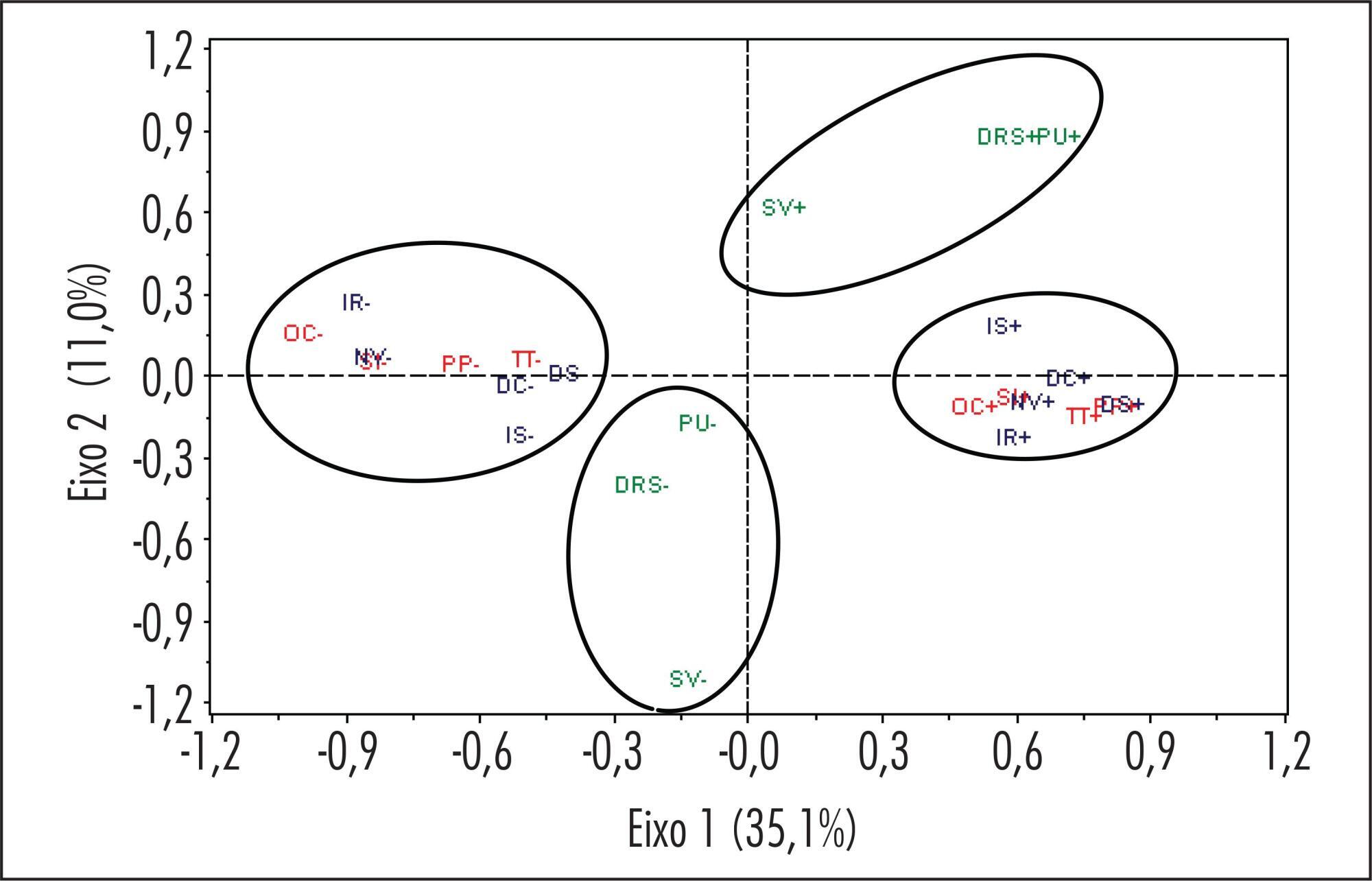
Search
Search in:
breast (42) breast cancer (42) breast neoplasms (95) Cesarean section (72) endometriosis (66) infertility (56) Maternal mortality (43) menopause (82) obesity (58) postpartum period (40) pregnancy (225) Pregnancy complications (99) Prenatal care (68) prenatal diagnosis (50) Prevalence (41) Quality of life (51) risk factors (94) ultrasonography (79) urinary incontinence (40) women's health (48)